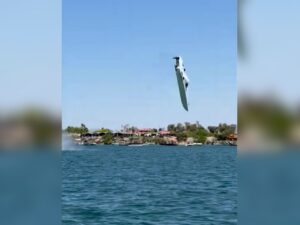The sea floor seems to have settled for now, but aftershocks and more quakes are still a risk, leaving locals vigilant.
Yesterday 2oceansVibe and much of the world’s media reported on the two massive earthquakes that shook the Aceh region of Indonesia and caused two back-to-back tsunami warnings to be issued for the entire Indian Ocean region. Both quakes and their aftershocks measured upwards of eight on the Richter Scale, leading to fears across the region that a giant tsunami might crash upon cities along the Indian Ocean rim. Even the South African media took up the story, projecting a wave might hit Durban and even Cape Town late last night.
ETV yesterday afternoon. Thankfully not an accurate prediction.
Not quite. The quakes and subsequent tsunami warnings saw thousands of residents in the Aceh region, as well as adjacent Indonesian settlements rushing for higher ground, memories of the 2004 tsunami that devastated the area and killed upwards of 170 000 in Aceh alone still raw in their minds, but what tsunami there was, was hardly one on the scale of 2004’s disaster.
Besides the violent quakes and aftershocks, which Geological Services in the area report occurred at a relatively shallow 33km below sea-level, the only tsunami reported was an 80cm high wave that lapped at Indonesia’s western shore. Most of the damage reported was caused by the quakes and aftershocks. The tremors were felt in neighbouring Malaysia, where high-rise buildings shook, and Thailand, India and Bangladesh.
Subsequently the tsunami warnings have been cancelled, though Indonesians have been urged by local authorities to practice caution in returning to the Western shores.
There were scenes of panic in the city of Banda Aceh yesterday as locals flooded the streets to escape to higher ground while tsunami warnings rang out and buildings shook around them.
Aceh, and Indonesia as a whole sits astride the volatile “Pacific Ring of Fire” which extends the entire circumference of the Pacific Ocean plate. The area is notoriously active with seismic activity. Just last year in March, Japan was devastated by an intensity 9 earthquake and subsequent tsunami, at a cost of billions of Yen and thousands of lives.
Compared to that tragedy and the one in 2004 that struck the Indian Ocean, yesterday’s events were not especially dramatic. Yet the damage and inconvenience to thousands of Indonesians lives remains an occupational hazard for life in one of the most beautiful, but also seismically volatile regions in the world.
One success story that did emerge from yesterday’s events was the relative speed and accuracy of the regions geological and seismic alert system, which allowed the global data to be relayed to local authorities in Indonesia.
The World Meteorological Organisation said communication systems set up after the 2004 tsunami appeared to have worked well.
“Our records indicate that all the national meteorological services in the countries at risk by this tsunami have received the warnings in under five minutes,” said Maryam Golnaraghi, the head of WMO’s disaster risk reduction programme.
A Seismic Report of yesterdays quakes reveals the widespread quakes and aftershocks that caused tsunami warnings to be issued across the Indian Ocean region.








